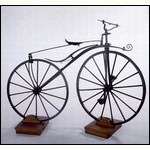|
A ride on a draisine inevitably resulted in dirty clothes and shoes. Draisine users, moreover, had to place their feet against the ground in order to brake, which resulted in quickly worn-out shoes. Such problems were solved in 1861 by the French maker Ernest Michaux. He added a couple of pedals to the front wheel, and, a few years later, also a pair of brakes: the bicycle was born. Because of the irritating vibrations produced by the wheels' impact with the ground, the bicycle was also known as the "boneshaker". It was nonetheless a success, both for producers and riders. The son of Napoleon III was seen riding Michaux bicycles about Paris (he was also nicknamed Velocipede IV), while on the other side of the Atlantic, Harvard and Yale students zipped about their campuses on two wheels.
.................................
|

Fig. 2 Michaux-type bicycle 1870-1875; Sargent, Paris. Iron. Made by the Parisian firm Sargent, the pedals are attached to the front wheel, as in all Michaux-model bicycles.
|
| |
 |
|
|
• The first boneshaker race took place in 1868 in Paris, in the Parc de Saint Cloud. The winner was James Moore, a friend of the Michaux makers. In three minutes and fifty seconds he covered 1,200 meters. He finished twenty meters ahead of two competitors and won a golden medal with a portrait of Napoleon III.
• 1869: 120 people, including two women, participated in the Paris-Rouen race (123 km). The winner was James Moore, who completed the route in 10 hours and 40 minutes, including stops.
• The first international bicycle exhibition took place in 1867. For the Michaux brothers, who exhibited their bicycles, it created enormous publicity: in 1865 their workshop produced 400 bicycles per year, in 1869 it produced 200 per day.
|
|
|
